If you appreciate off-the-beaten-path adventures, then you need to visit Syria. Step back in time by visiting the world’s oldest city or trek through war-ridden monuments that still remain proud.
The Syrian war, which started in early 2011, has damaged and destroyed big parts of the country, but not all. Luckily (and to the surprise of most people), most of the historical sites in Syria survived the brutal war.
And now, almost all the historical places in Syria are once again possible to visit for foreign tourists.
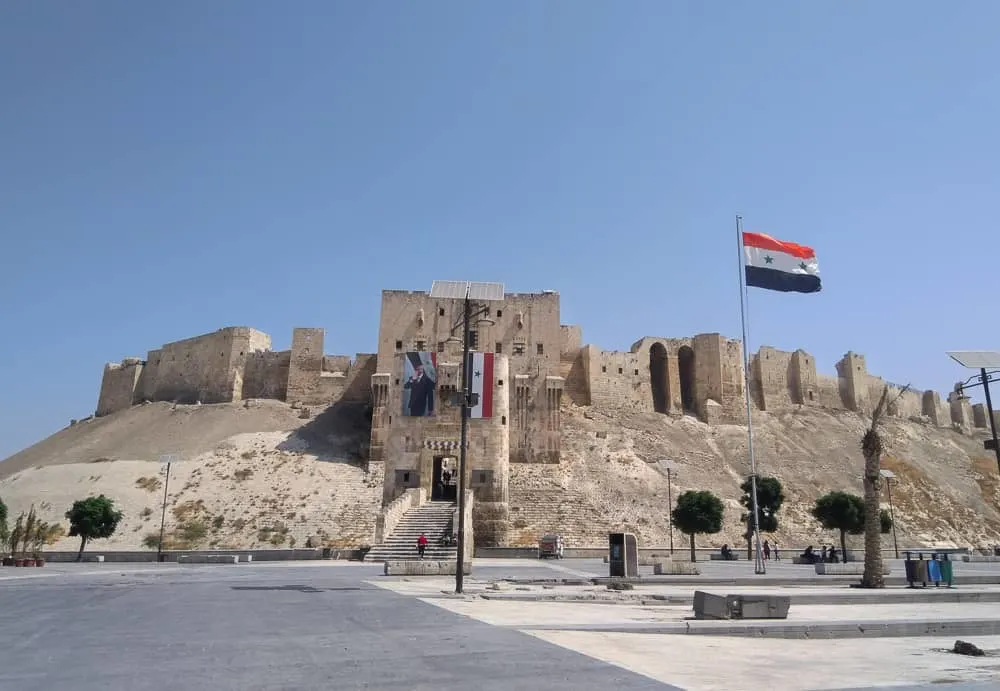
Syria Landmarks | War with ISIS
We all saw what happened to the old Roman Ruins of Palmyra out in the Syrian desert when Desh (ISIS) blew up parts of the historical city in 2015.
Unfortunately, all the Syria historical places in terrorist-held Idlib have been looted and heavily damaged, something which happened all over Syria early in the war by terrorist groups to sell historical artifacts and relics on the black market like what happened on the Ancient ruins of Apamea.
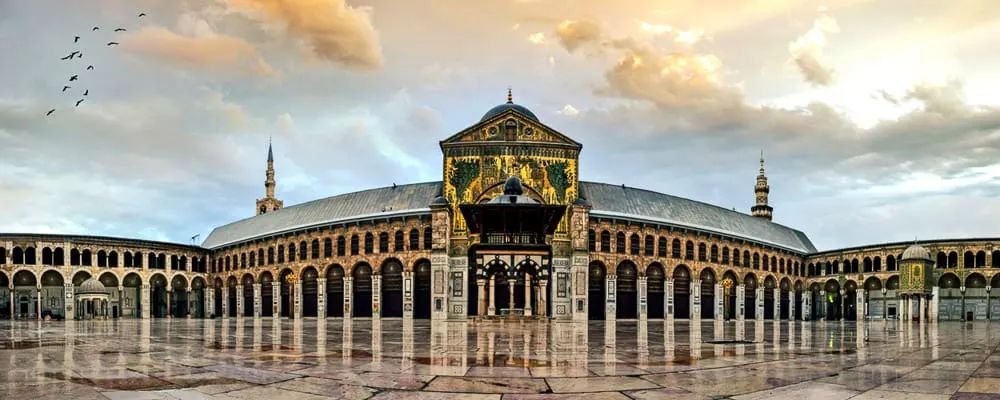
While almost all historical places in government-controlled parts of Syria have survived, some with minor damage, others with major damage from terrorist shelling and bombs.
But luckily today, almost all the Syrian beautiful places in the Government-controlled part of the country have been restored, if not already restored, so is work currently undergoing.
Traveling to Syria is one of the most eye-opening experiences and is a haven for the unusual traveler.
This guide reveals incredible places to visit in Syria, as well as what you can expect.
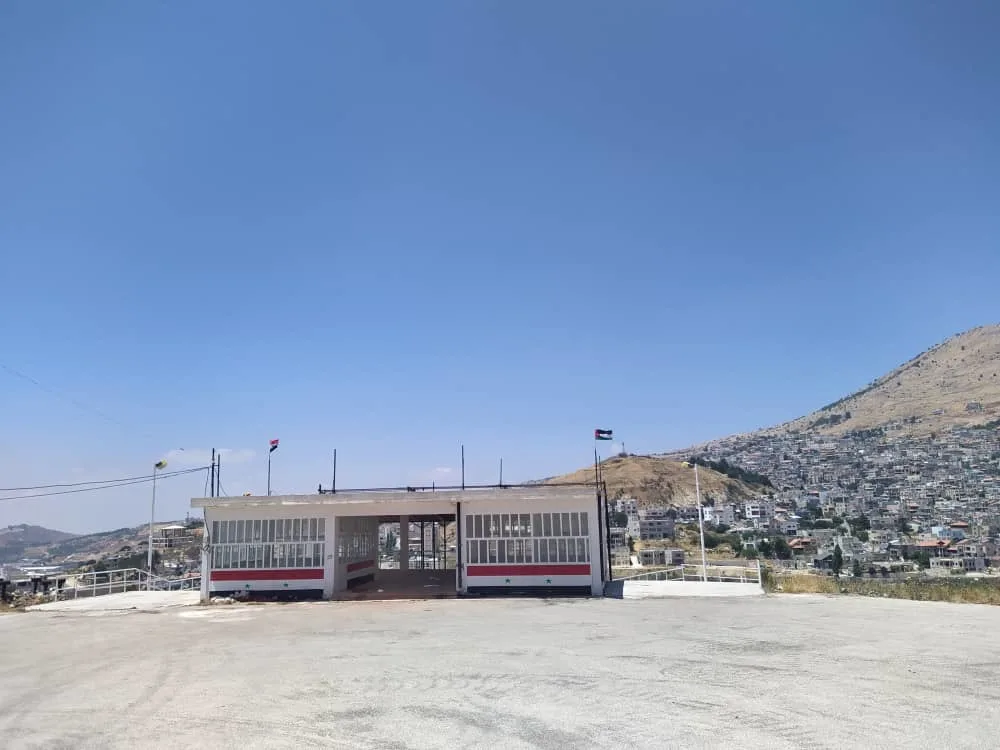
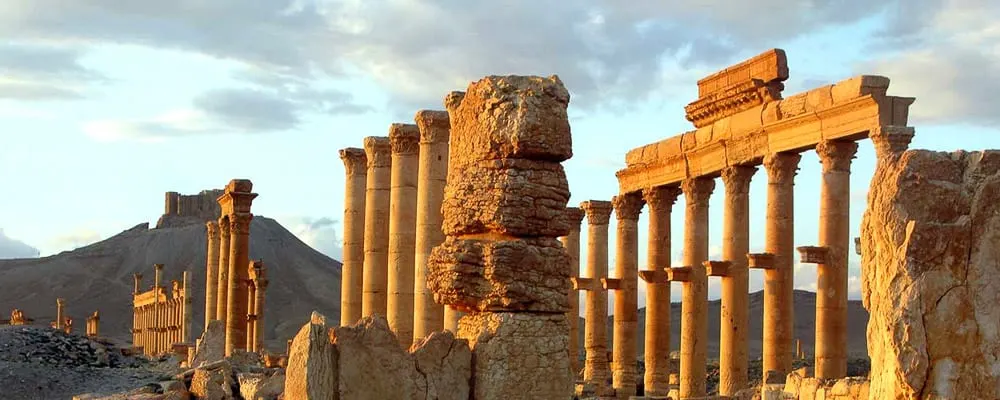
Syria Historical Sites | 11 Places to Visit in Syria
The easiest way of getting around Syria and discovering the iconic landmarks is to make use of a guide.
Luckily for you, I’ve traversed the area and have first-hand knowledge of Syria. I’ve outlined the best historical places to visit in the country below.
One thing I must add is that you need to travel quite a bit. I found having a reliable backpack an essential part of my travels. As well as a stainless steel water bottle because it gets super hot here.
Krak Des Chevaliers: The Greatest Crusader Fortress in the World
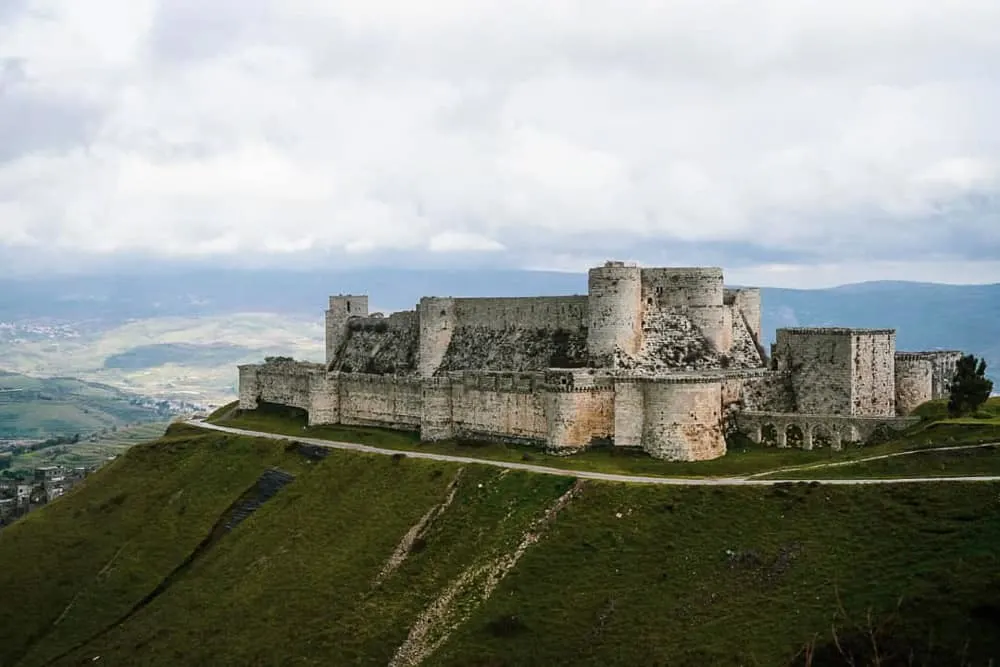
The Krak Des Chevaliers is a massive Crusader fortress built during the First Crusade on a strategically important spot 40 kilometers from the city of Homs or Hims, called l’Chamelle by the Crusaders, in the middle of the Syrian desert.
What made this spot so strategic was that only one route led from the city of Antioch south to Beirut, Lebanon, and the Mediterranean, and that route passed through Homs Gap.
Krak des Chevaliers sits atop the 650-meter hill which dominates the surrounding countryside and overlooks this ancient highway.
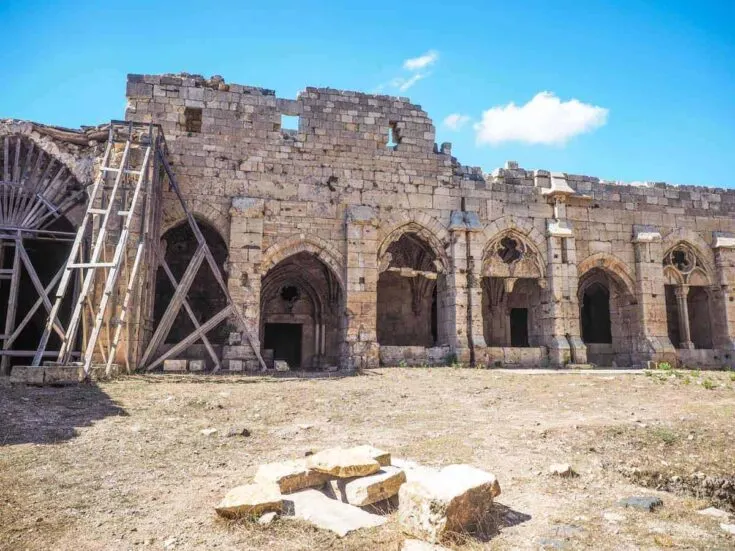
Click here to read more about Krak Des Chevaliers and how to visit.
The Krak was originally a much smaller fortress built by the Emir of Aleppo.
In 1110, it was captured by Tancred, Prince of Galilee and one of the most famous Crusaders; the fortress later passed into the possession of Knights Hospitaller, the most powerful religious-military orders of the Crusades.
The greatly expanded fortress served as their base of operations in the Middle East for centuries.
Built according to the taste of its masters, Krak des Chevaliers is a typical example of Gothic architecture, uprooted from Western Europe and transferred to the Middle East.
Even today, it is one of the best-preserved examples of European medieval military architecture and an iconic tourist attraction in Syria.
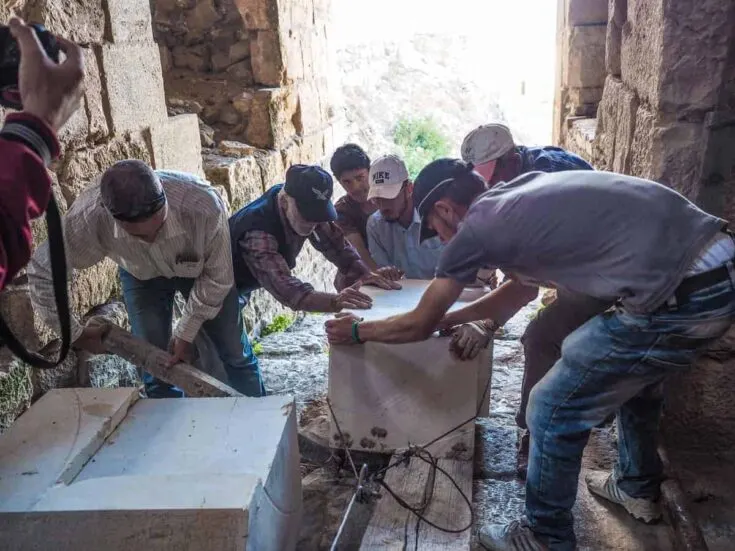
The fortress could accommodate a garrison of 2000 soldiers. The inner protective wall is over 3 meters thick.
The inner castle is protected by seven towers, each 10 meters in diameter.
The storeroom is 120 meters long and could hold supplies that would permit the defenders to survive a siege for about five years, with stables that could accommodate up to one thousand horses.
Krak des Chevaliers withstood numerous attacks by Muslim forces, even a siege by the mighty Saladin in 1188.
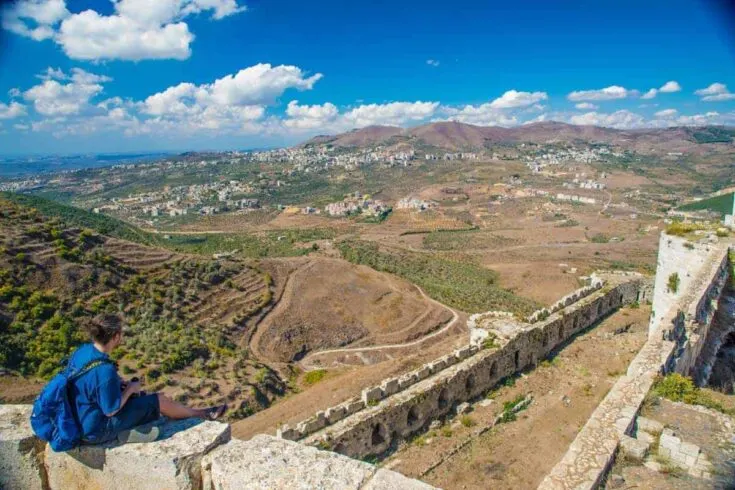
Legend has it that Saladin managed to capture the commander of the fortress and ordered him to make the defenders open the gates.
Allegedly he did as he asked, speaking in Arabic, but then commanded in French that his men defend the castle to the last warrior.
In the end, sheer force-of-arms was not enough to conquer these mighty walls.

The castle fell to a cunning trick. In 1271, Baibars Mamluk, Sultan of Egypt, managed to take the fortress after sending a forged letter to the defenders in the name of their master and commander in Tripoli ordering them to surrender the castle.
After their expulsion from Syria and Levant, the never-conquered (though easily duped) Knights Hospitaller moved their headquarters to Cyprus and then to Rhodes, retreating ever westwards until they settled on Malta, where they survived until Napoleonic times as the Knights of St. John.
Krak des Chevaliers is on the UNESCO list of World Heritage Sites and one of the Syrian landmarks that draw in hundreds of dark tourists.
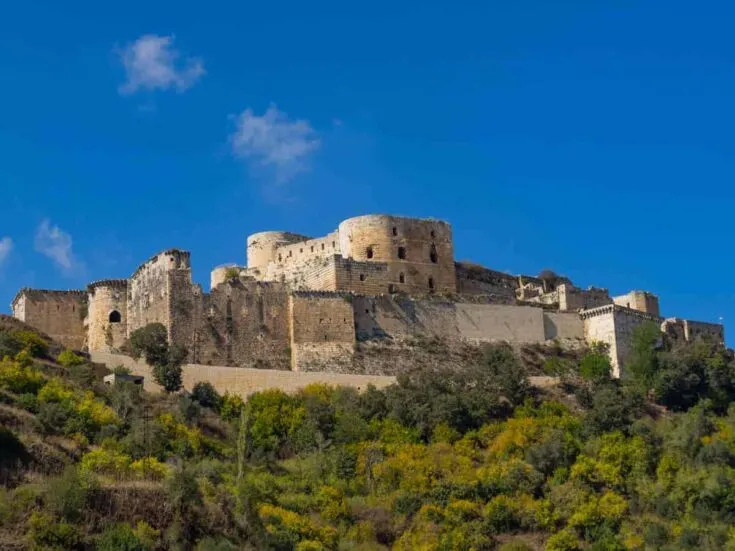
Palmyra: Once The Greatest Roman Ruins In The World
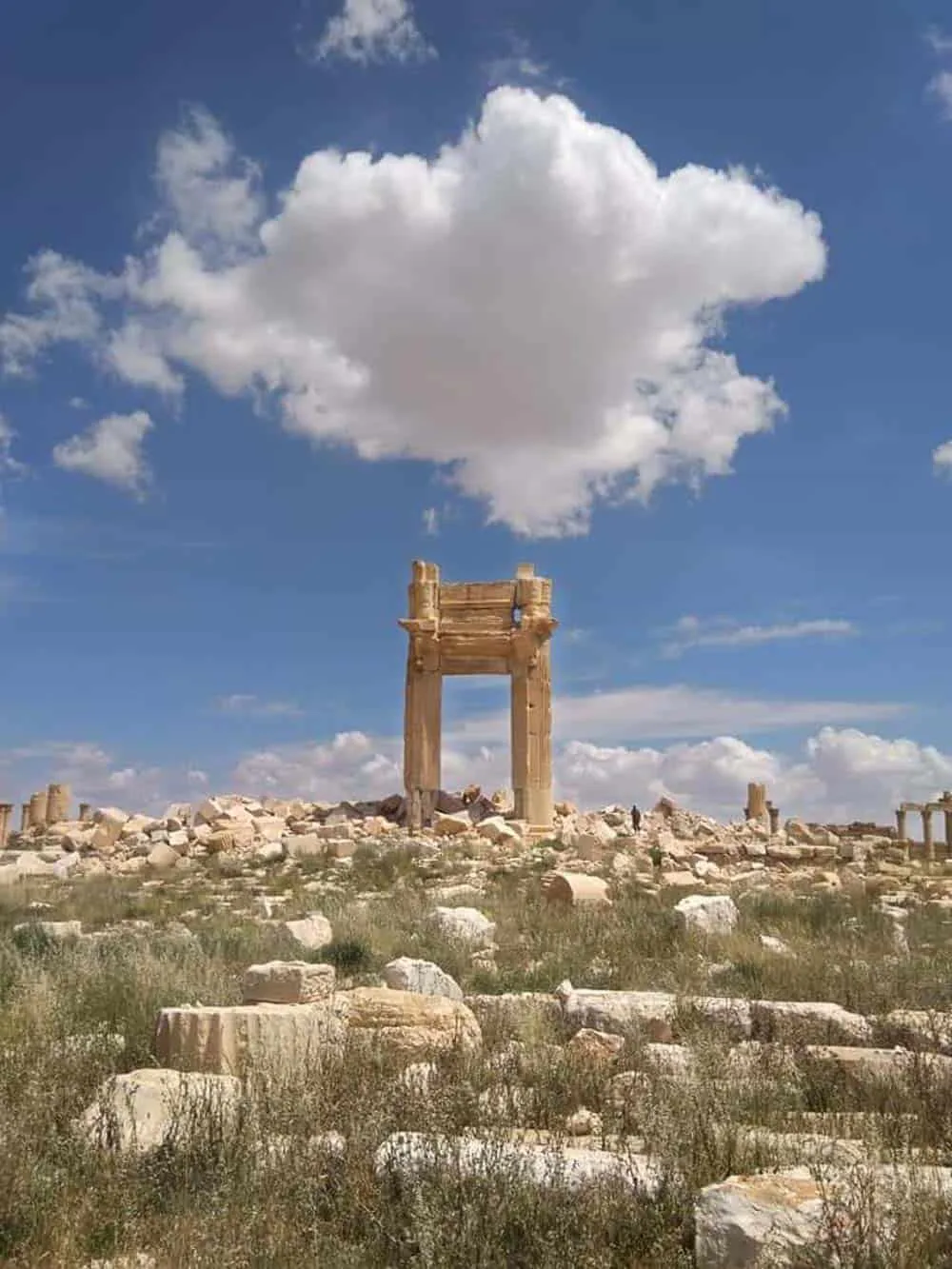
Palmyra: LED BY QUEEN ZENOBIA, A third-century ruler who was later taken to Rome and paraded through the streets in golden chains.
Palmyra is one of the landmarks in Syria that was once a rich city on the Silk Road, a gateway to the West for travelers returning from the Orient.
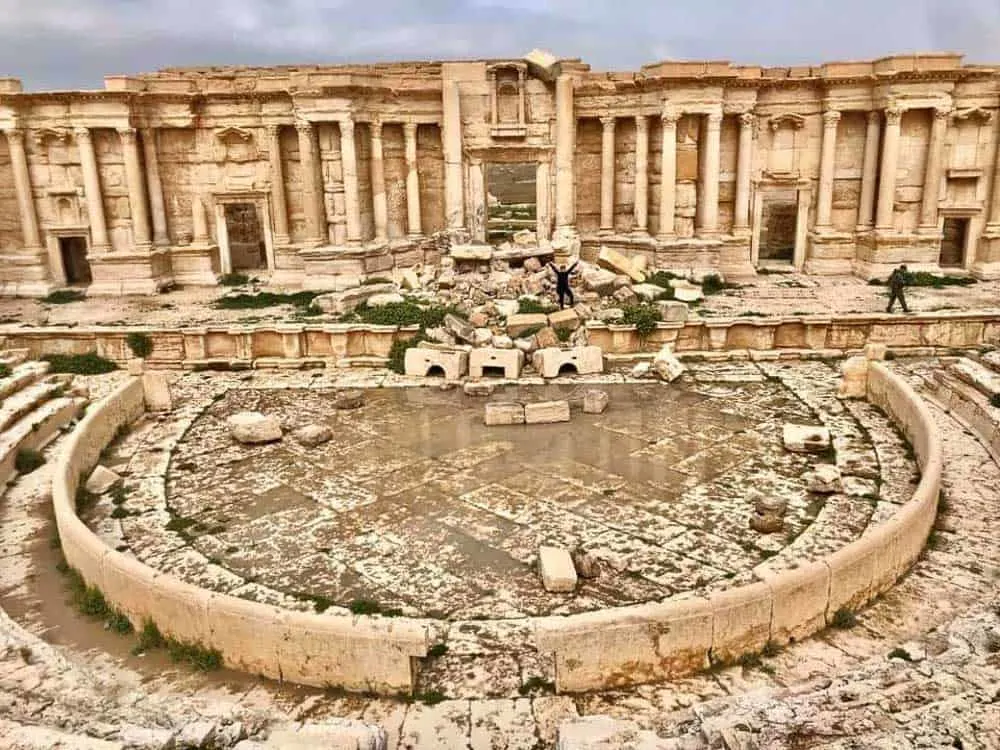
Under Zenobia’s rule, Palmyra actually took territory from the Romans–and the short-lived Palmyrene Empire stretched from Turkey down to Egypt.
The empire lasted for thirteen years, and then Aurelian decided to take it back. He defeated the Palmyrenes and took Zenobia back to Rome, where she was accepted into society and eventually became a lively and much-admired Roman matron.
In 1980, it was declared a UNESCO world heritage site – making it one of the most popular Syria tourist spots.
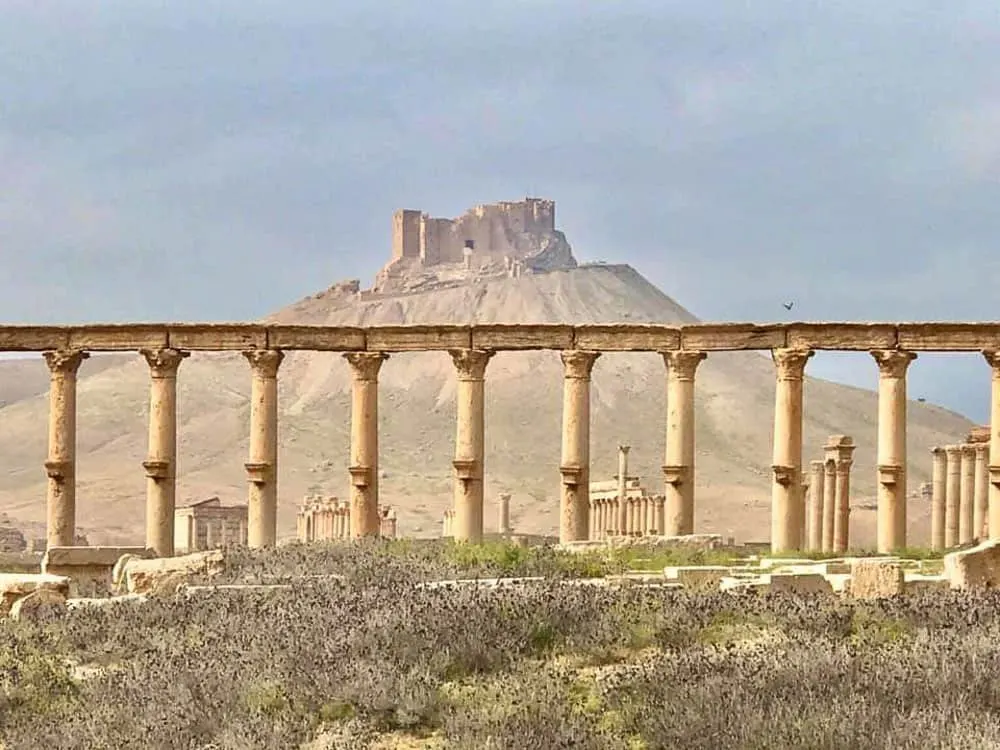
For most of the past few years, Palmyra was a small town with a large and lush oasis next to it; the ruins of the old city covered the plain for a good square mile.
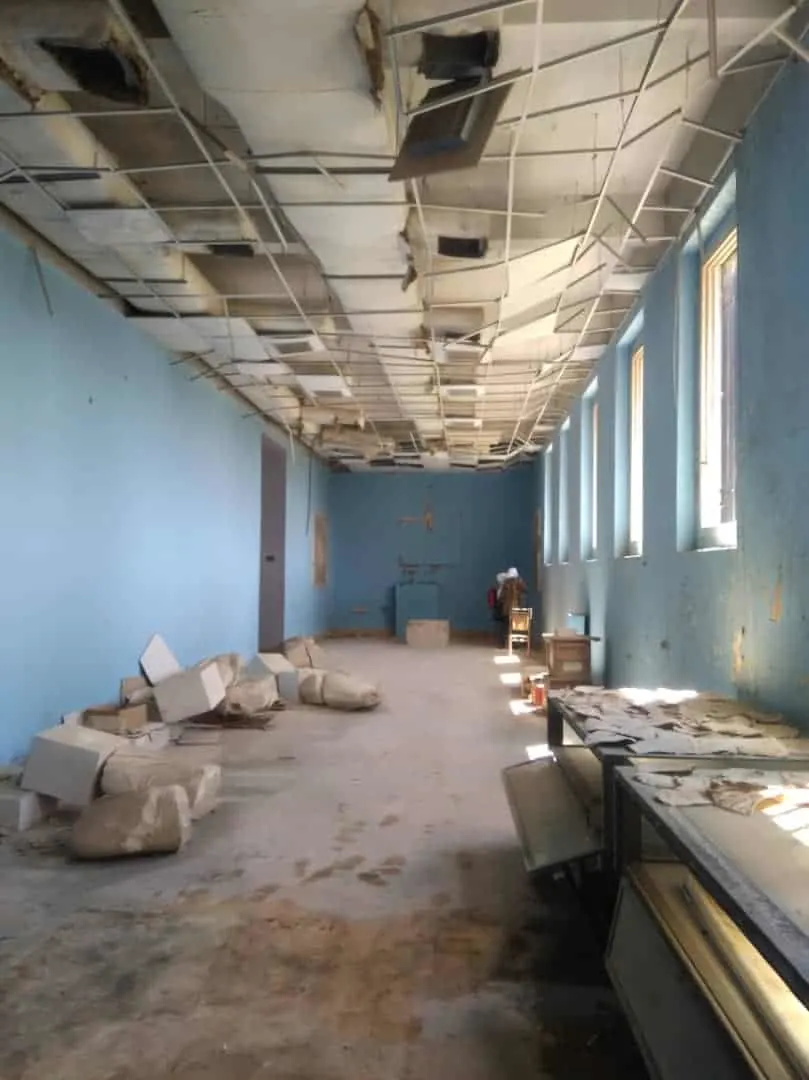
Beautiful Romanesque columns carved from the local golden sandstone marched down long avenues; in the early morning and early evening, the brilliantly blue sky contrasted strikingly with the warm tones of the stone and the long, deep shadows.
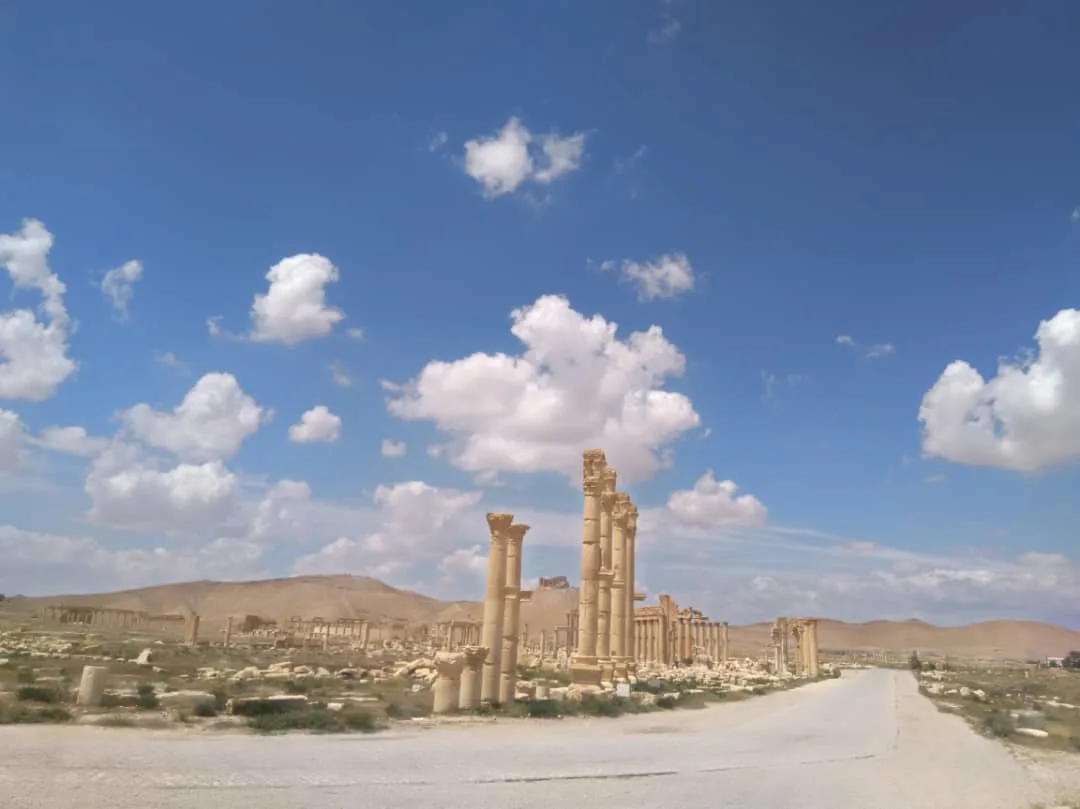
Today it is one of the most beautiful places in Syria and a reminder of a mysteriously lost empire, worthy of pulp novels.
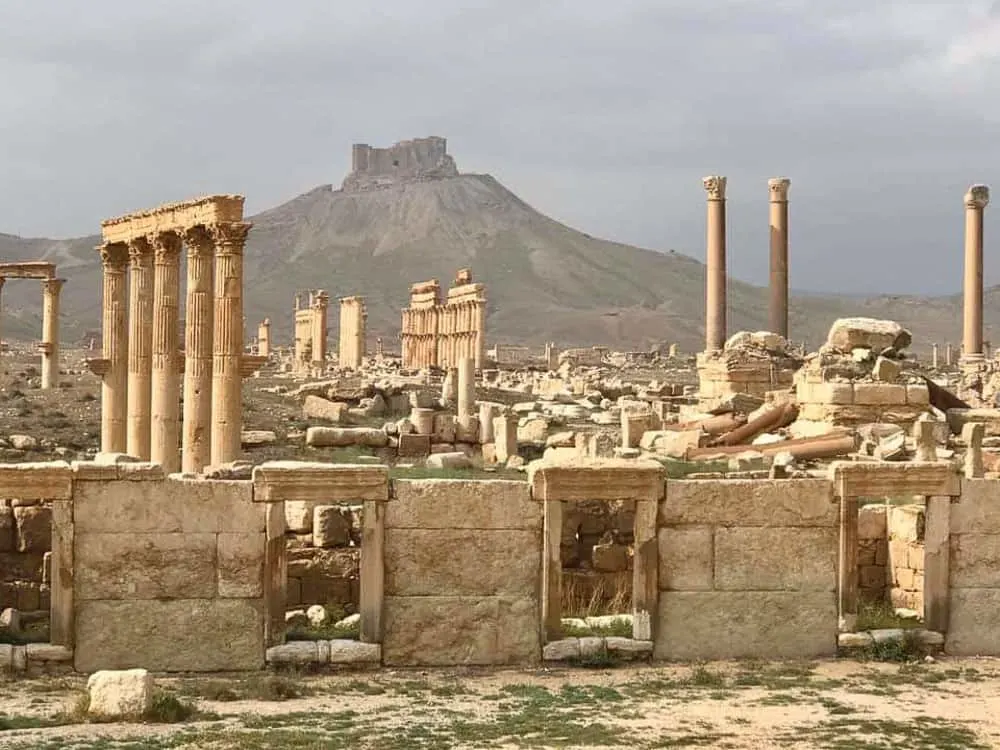
Unfortunately, in May of 2015, the area fell under the control of the Islamic State of Iraq and the Levant (Daesh), and its temples, monuments, and other buildings were subsequently blown up, razed, or otherwise destroyed.
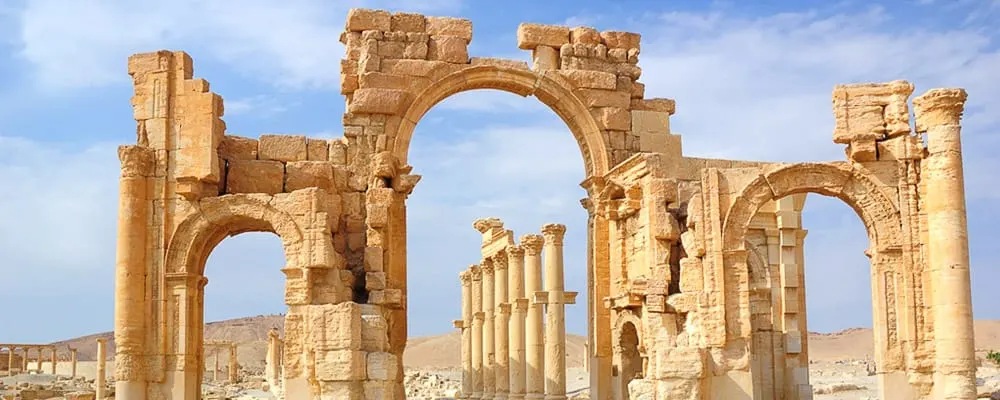
Overall so was about 30% of Palmyra completely destroyed, including the famous Temple of Baal Shamin.
Busra And The Great Roman Ruins
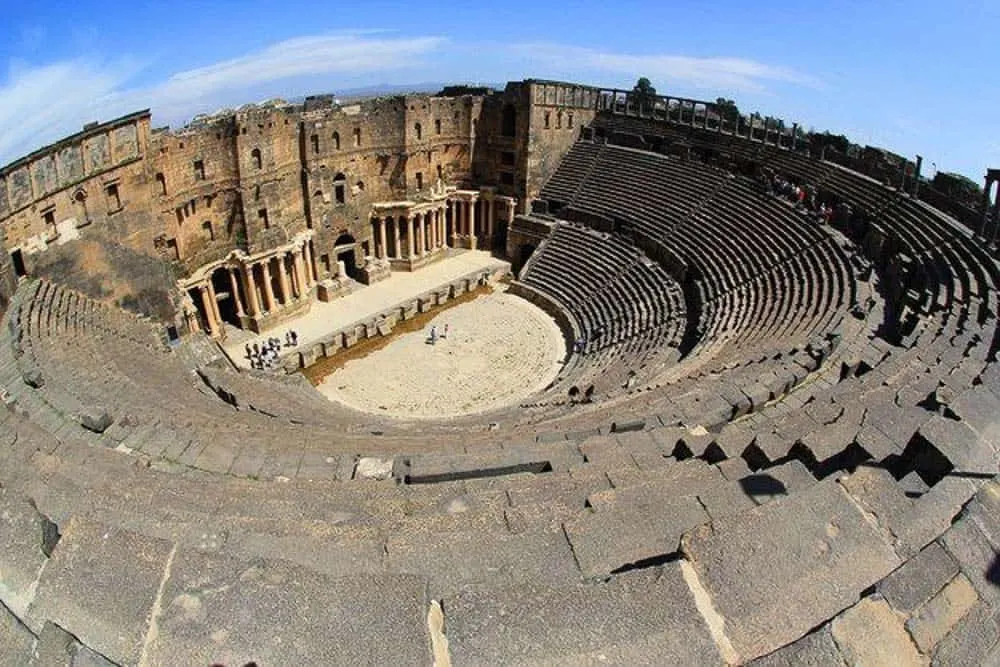
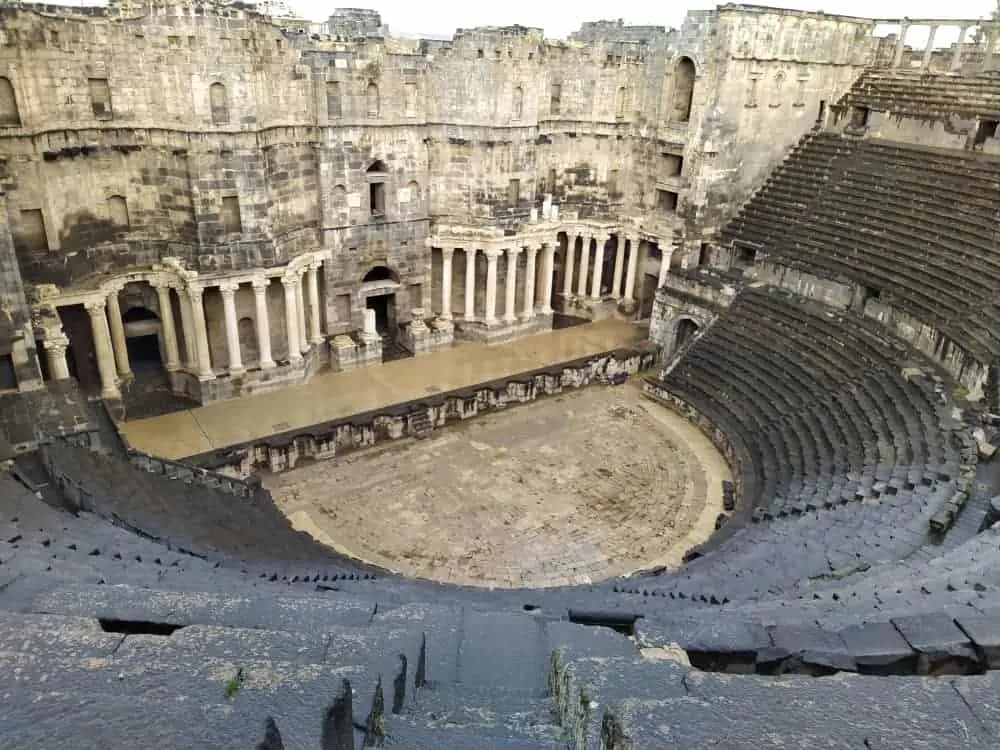
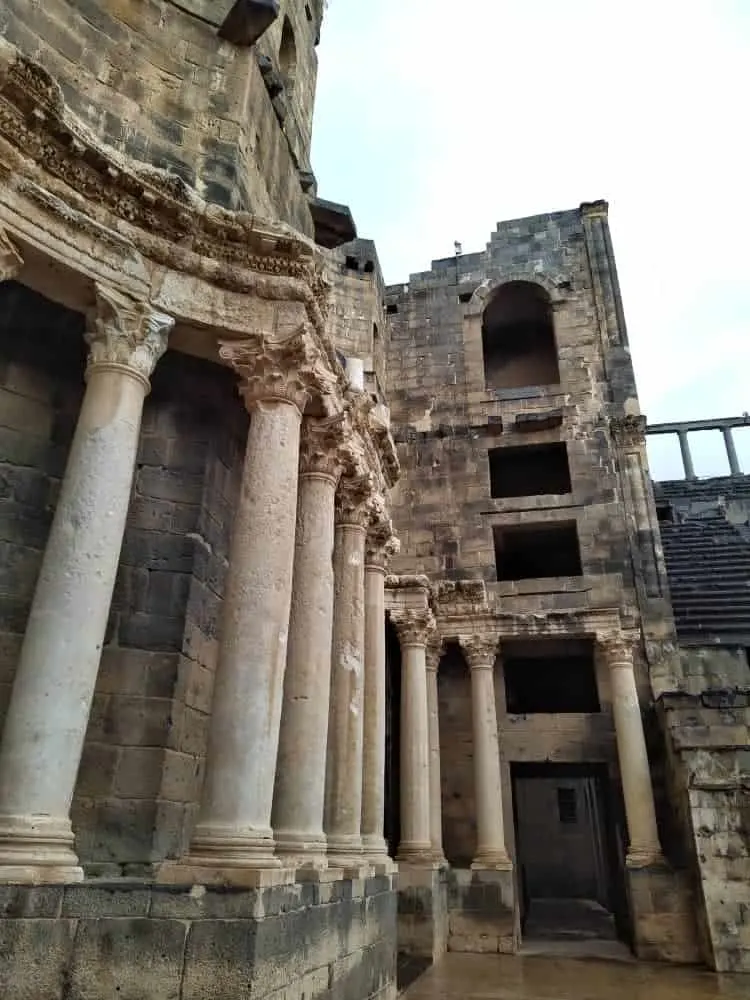
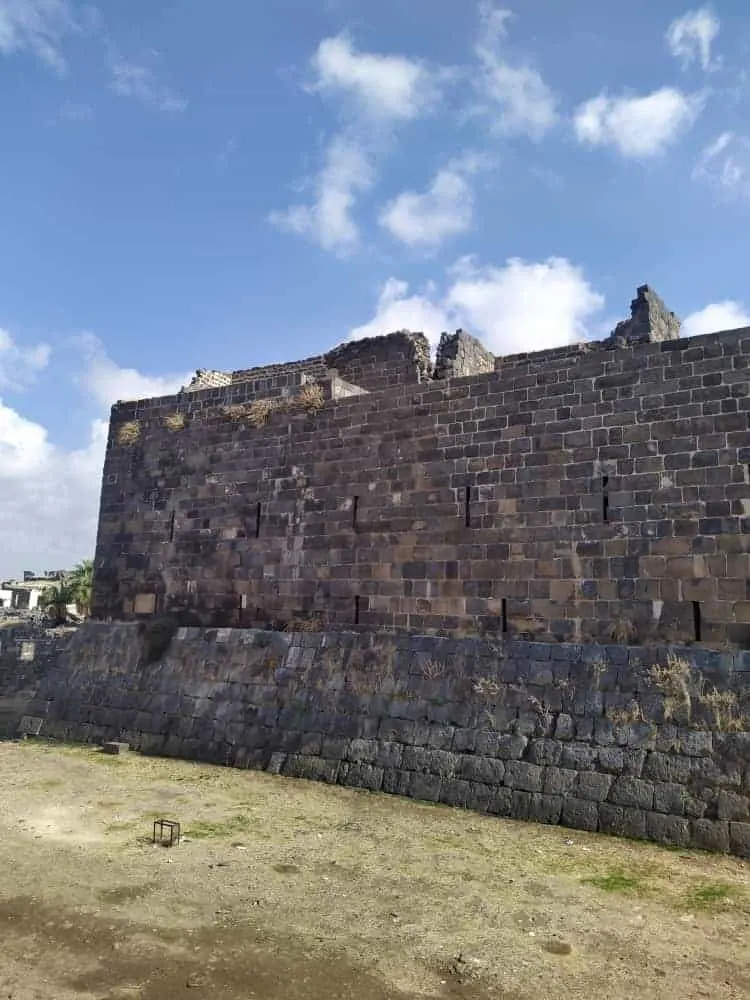
Busra: One of the most ancient cities of Syria is Bosra which is one of the most popular tourist destinations in Syria.
Bosra is renowned all over the world as one of the oldest cities- it has been the capital of the Roman province in ancient times.
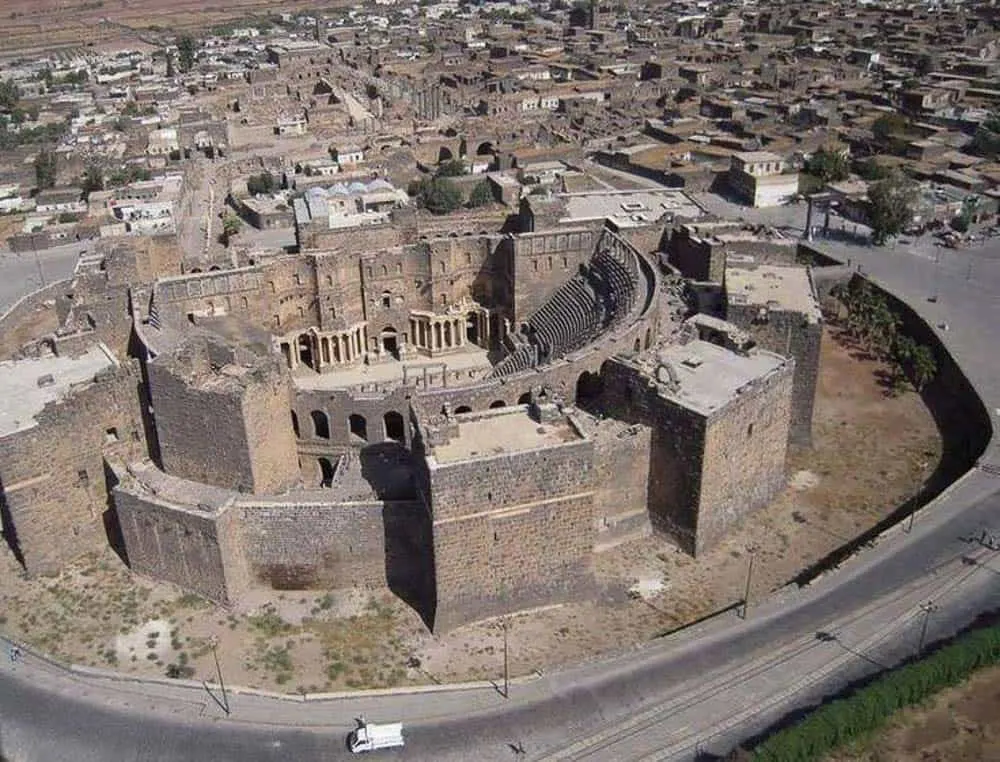
The major attraction of this city remains its well-preserved ruins from the Roman culture: a Roman amphitheater that has remained absolutely untouched in the time and shows the genius of roman architects in detail.
There are also many churches, mosques, monuments, and arches.
Reconciliation took place between the local population and the government in 2018, and there was calm in the place, and visiting the area was available, but without overnighting due to the lack of accommodation services for tourists.
Overall, only about 5% of this Syria sight has been damaged in the Syrian war.
Aleppo: The Great City Of Syria
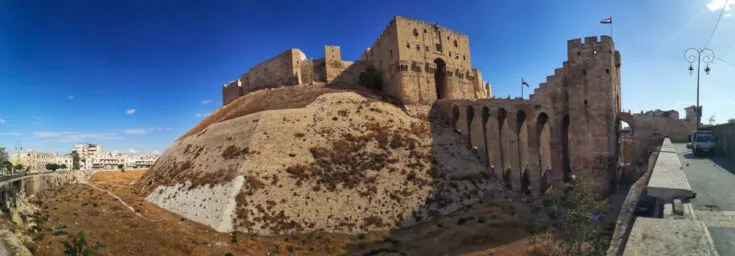
Aleppo: Before it became a 21st-Century battleground, Aleppo’s historic Old Quarter embraced the world’s longest and oldest network of souks—Arabic for covered markets.
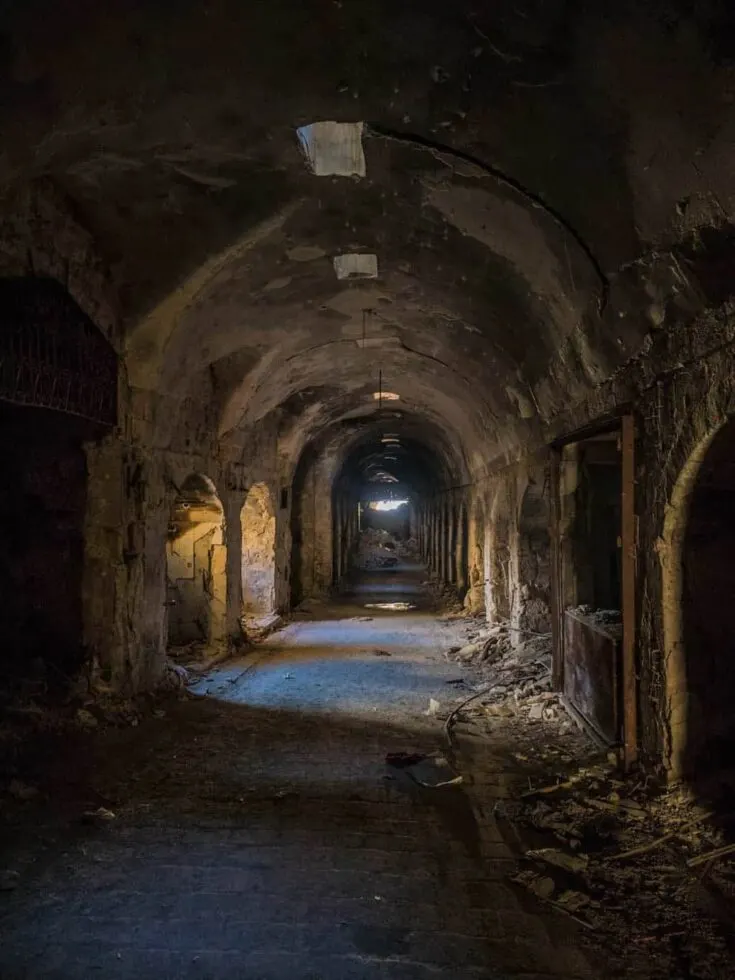
There were 45 in all, dating back to medieval times and forming a 13-kilometer labyrinth where Syrians and foreigners came to shop, work, and socialize.
Visiting here reveals famous buildings in Syria that allow you to get the feeling that you’ve transported back in time.
Between 2012 and 2016, government and rebel forces fought for control of Aleppo, which was then Syria’s biggest city.
By the time government troops regained control of the Old Quarter, almost all the souks and all but a hundred of their 1,600 shops had been damaged or destroyed—demolished by explosives, pitted by shrapnel, and charred by fire.

Syrian authorities and foreign heritage organizations aim to bring the Old Quarterback to life by rebuilding the souk network bit by bit.
One of the first sections to be restored is the Saqatiya souk, a 100-meter cobblestone alley containing 53 shops.
Saqatiya means a seller of meat offcuts, and under the souk’s arched roof, vendors once again shout their wares, including fresh meat, nuts, sweets, clothing, and toiletries.
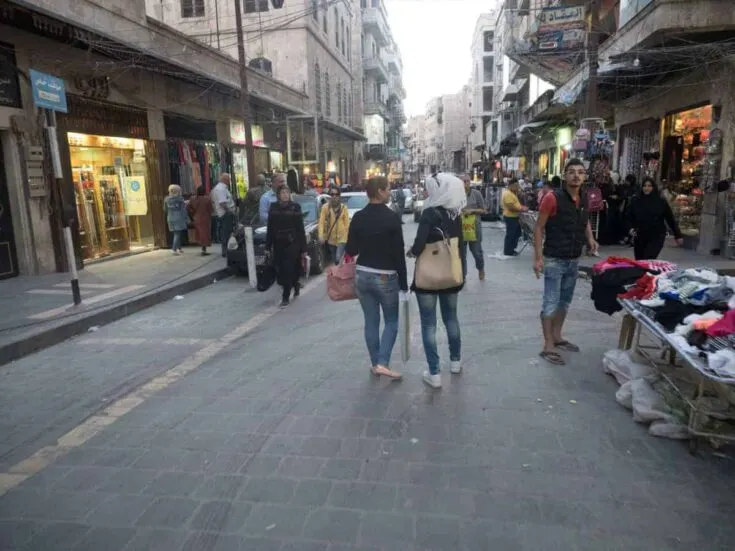
Al-Saqatiya, sometimes spelled al Saqatiyah, re-opened in 2019 and is a short stroll from the 11th-century Great Mosque, Aleppo’s war-damaged spiritual heart.
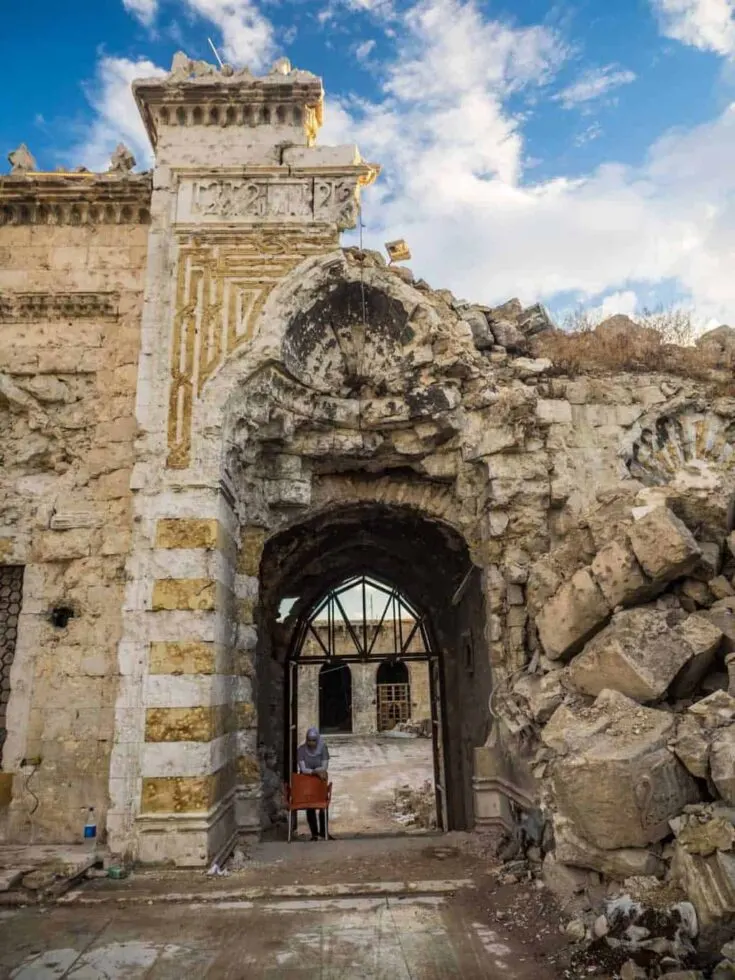
Reconstruction of the souk cost $400,000 and took about eight months, the Associated Press reported.
The project employed about 60 workers and was funded and supervised by the Geneva-based Aga Khan Trust for Culture, which promotes the restoration of historic sites as a catalyst for social and economic development.
Syrian architect Bassel al-Daher said about 30 percent of Saqatiya was damaged in the war.
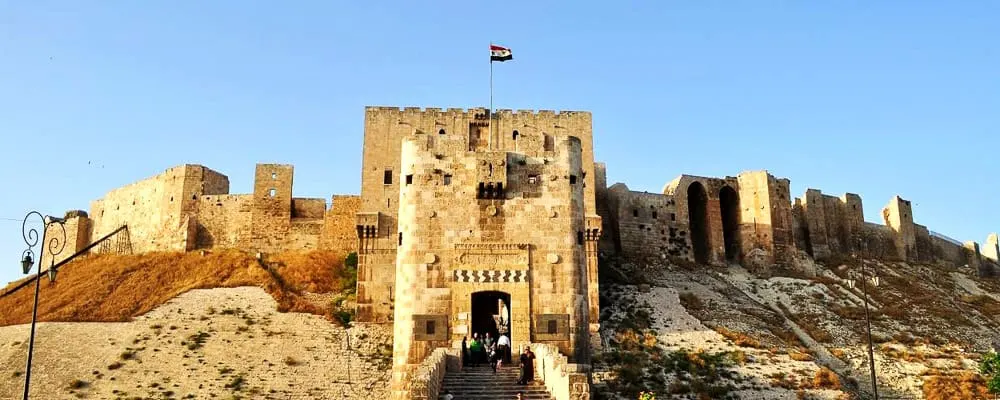
He told AFP that its reconstruction was “the project of a lifetime.”
Aleppo’s location, midway between the Mediterranean Sea to the west and the Euphrates River to the east, put it at the center of international trade for millennia.
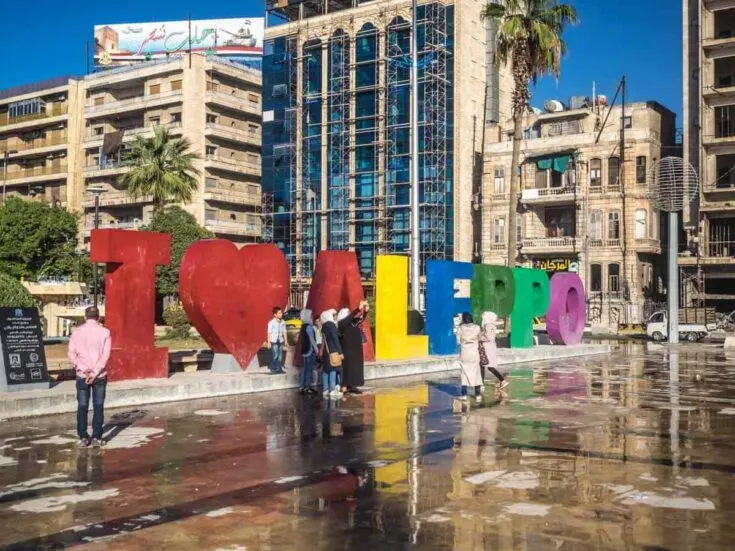
Long-distance caravan trains brought Persian silks, Indian pepper, and other valuable cargoes to the city.
Products found their way west by way of European merchants who lived in Aleppo from at least the 16th century.
They tapped into a multi-ethnic and multi-faith commercial network that stretched as far as Chengdu in China.
Overall so was about 60% of the historical part of Aleppo damaged/destroyed.
Damascus: The Capital City with the Oldest Famous Landmarks in Syria
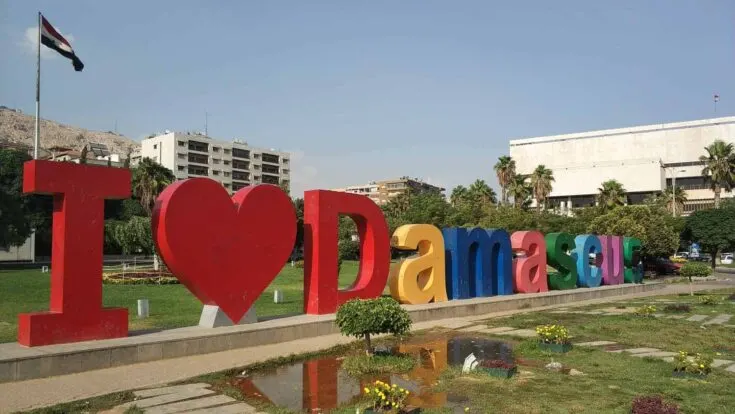
If you’re wondering what to visit in Syria that’s more alive with tourists and excellent food, Damascus, the capital, should be your first stop.
The city offers endless exciting and attractive spots to visit. Damascus is the largest city in Syria and is also known as the oldest city in the world. In this city, you can enjoy some Middle-Eastern food, along with ice cream, candy, and cakes.
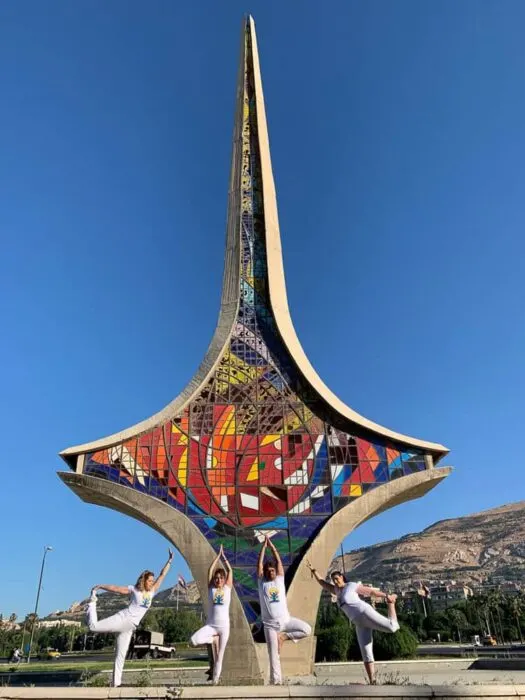
Damascus is considered one of the best places in Syria for finding amazing souqs that are spread across the city. They are considered to be exceptionally different and offer a unique flavor, undoubtedly a major attraction of the country.
As you walk about in the warm darkness of these streets with their fragrant scents, spices, and colorful merchandise spilling out of the shops onto the pavements, you enter the strange world of exotic legends.
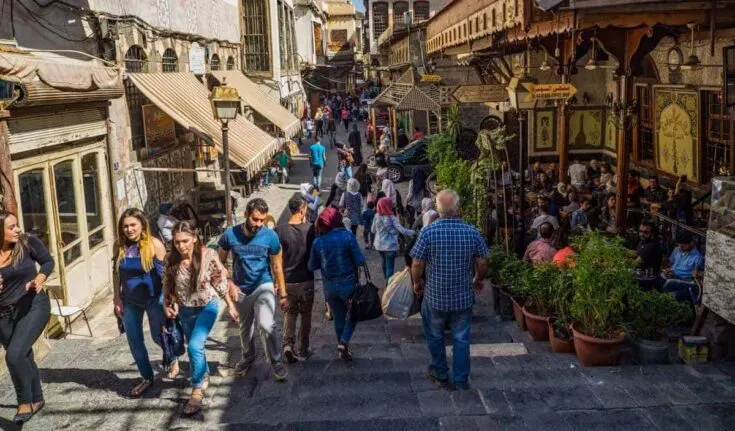
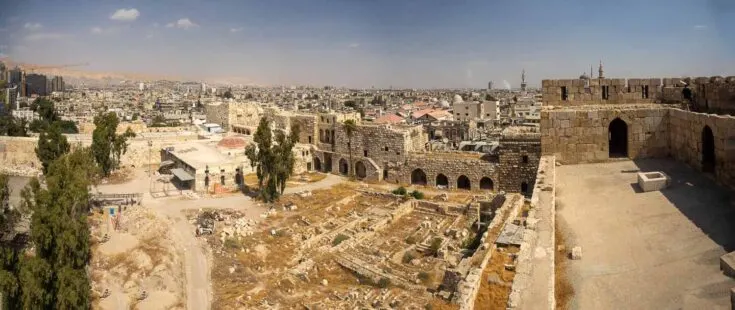
One of the extremely popular souks of Syria is the Souq Al Hamidiyeh, where you can find some of the best traditional goods in the country.
This souq belongs to 1863, to the rule of the Ottoman Sultan Abdul-Hamid, after whom the souq was called. It is covered with high iron vaulting, so old that sun rays filter through it into the darkness of the souq.
The shops here sell everything you need.
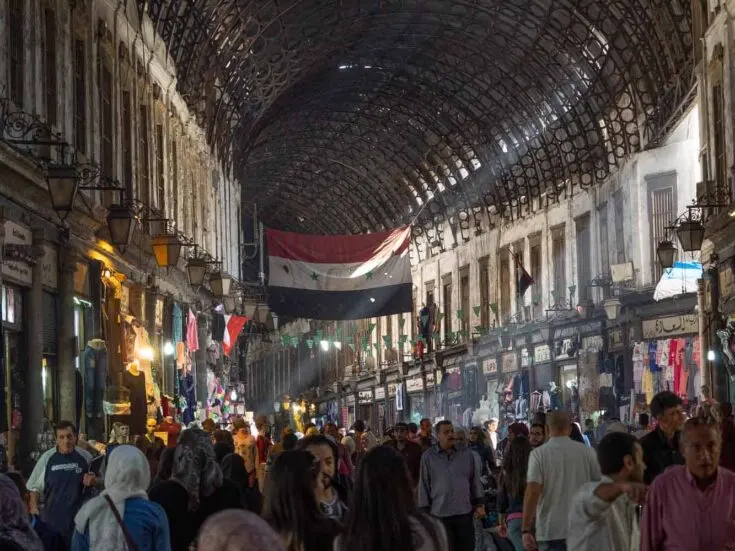
The heart of the capital, Damascus, was kept away from the war, with the exception of mortar attacks by armed groups in the vicinity of Damascus.
In the last years of the war, Damascus regained safety and activity after the Syrian government forces took control of its surroundings.
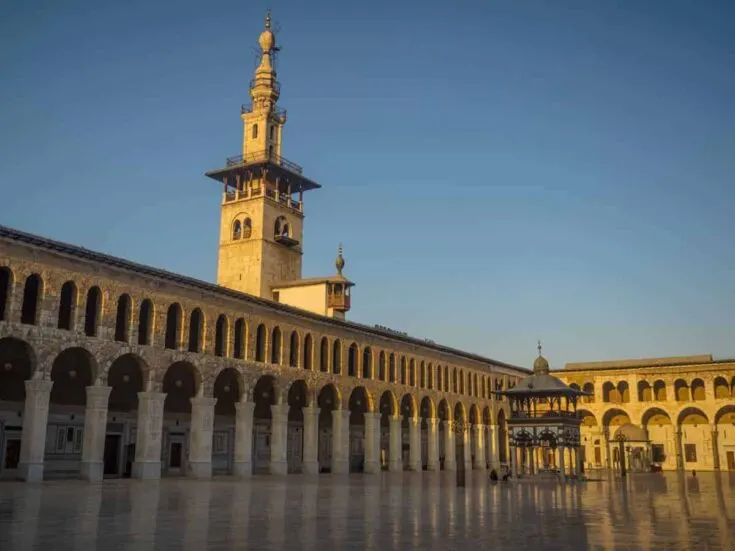
Damascus holds famous Syrian landmarks in perfect condition, as none of them have been destroyed by civil unrest and war.
Homs: Once a Devastated Town
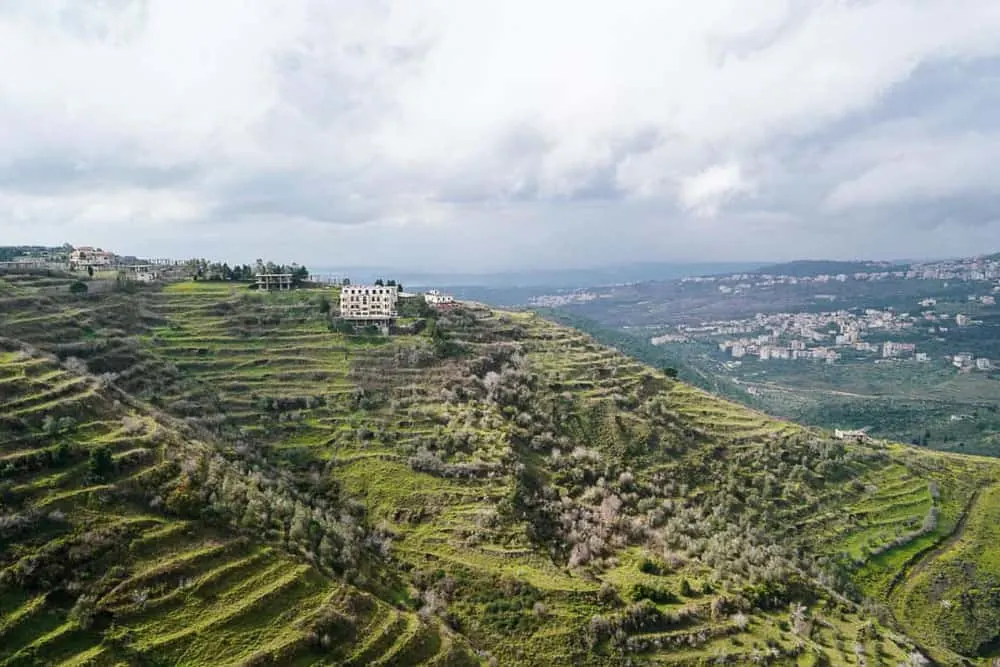
You will experience the largest amount of feelings when you visit Homs, the Syrian city that has suffered the most from the ravages of the war.
You will find the local population is much less than before the war, but with their lively spirit and desire for life, you will find them trying to restore what they can with modest means.
It was destroyed by the war and was restored after that.
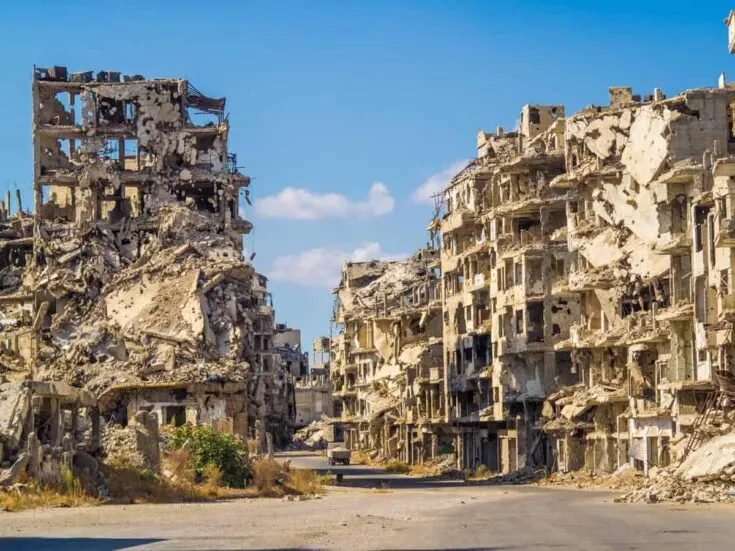
The same applies to the Church of Umm al-Zinar, which contains the belt of the Virgin Mary.
While it’s not your classic tourist place in Syria, you will leave Homs with a huge amount of excitement.
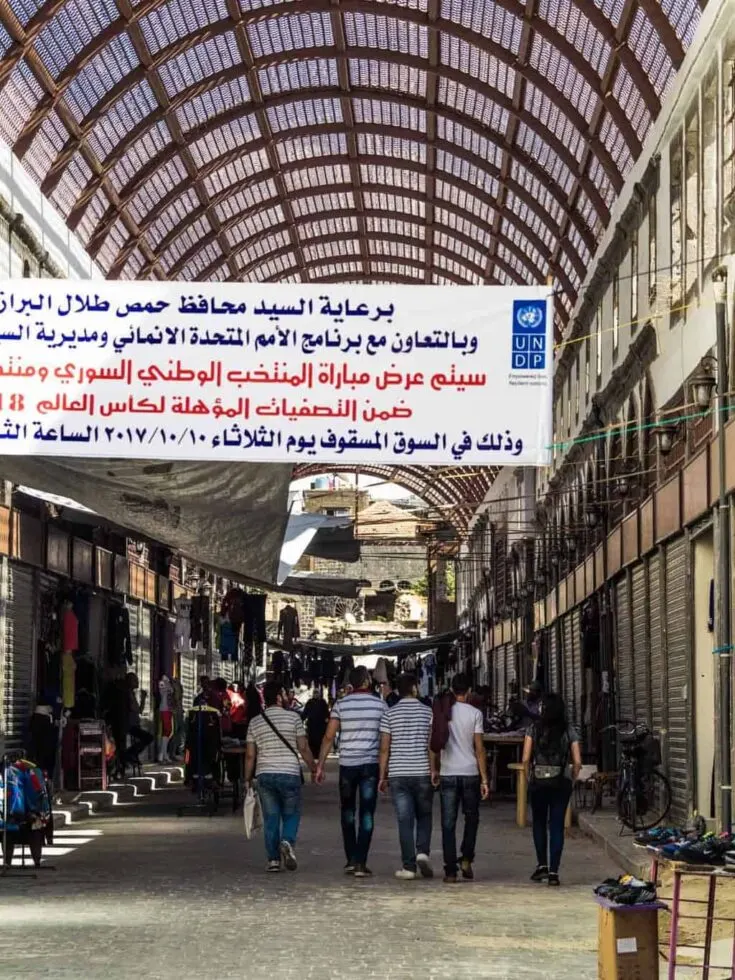
About 20% of Homs were destroyed.
Hama: The Fourth-Largest City
Hama: Hama is one of the most popular tourist destinations in Syria and the fourth-largest city. It is located on the banks of the Orontes River in west-central Syria, north of Damascus.
The city is renowned for its 17 norias used for watering the gardens, which it is claimed date back to 1100 BC.
Though historically used for the purpose of irrigation, the norias exist today as an almost entirely aesthetic traditional show.
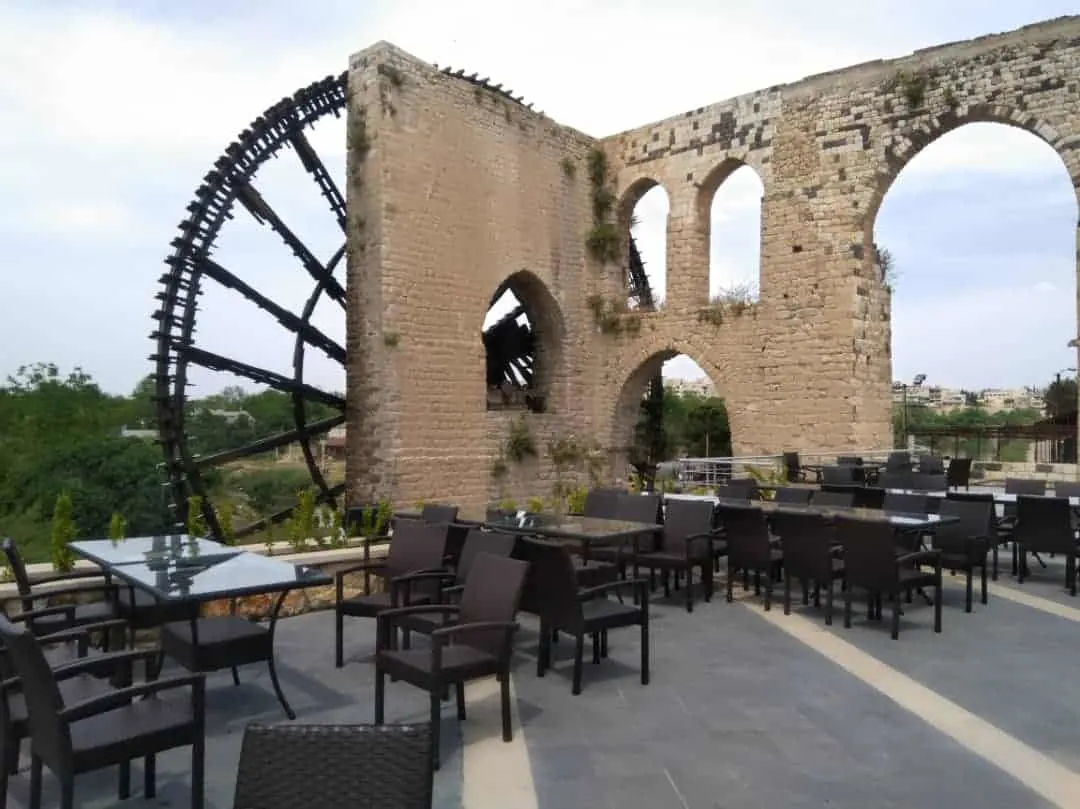
It’s one of the most visited Syrian tourist places because of the Hama Water Wheels, where travelers can grab a bite while overlooking the attraction.
They were built during the ancient Byzantine times in order to move water to aqueducts, but only 17 of the wheels are preserved today.
Lots of people go there to learn more about life in Roman times and the genius of the architects, who have built them so perfectly and specifically.
Coming to Syria, it is obligatory to go and see the water wheels on the bank of the Orontes River. It is considered to be an absolute must-see major landmark in Syria.
Latakia: Principal Port City Of Syria
Latakia is one of the most popular tourist attractions in Syria that dates back to the Ancient Greek era. Even today, it is a prominent commercial port city in Syria.
Largely consisting of white stucco high-rising structures and streets lined with palm trees, Latakia is also home to the Tishreen University, which is one of the largest educational institutions in the country.
The city of Latakia offers some of the most interesting tourist spots and monuments in Syria.
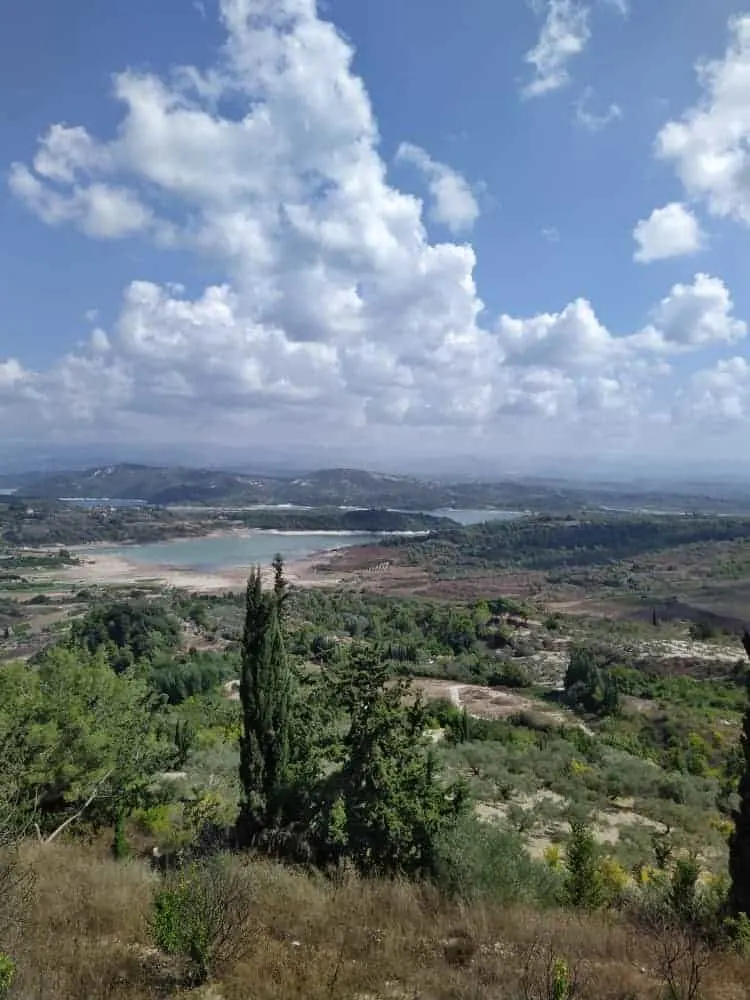
The Citadel of Salah Ed-Din is one of the most impressive citadels of the country and one of the most famous tourist attractions of Syria.
This magnificent piece of work is completely surrounded by forests; this beautiful Citadel is still in good condition.
It was included in the list of UNESCO World Heritage Sites in the year 2006.
The place welcomes many tourists from the whole world who wish to feel the atmosphere of the ancient citadel!
The ruins of Ugarit are believed to be the most prominent part of the country of Syria. It is also of great scientific interest from historians and archaeologists because of the city that once existed there.
This city is 6000 years old and is well protected by a wall for protection.
The city was destroyed at the end of the Bronze Age by the so-called “Sea people” – this was a union of sea sailing people who aimed to reach control over Egypt and caused damages and destruction in many Mediterranean countries.
Maaloula: Beautiful And Famous Place In Syria
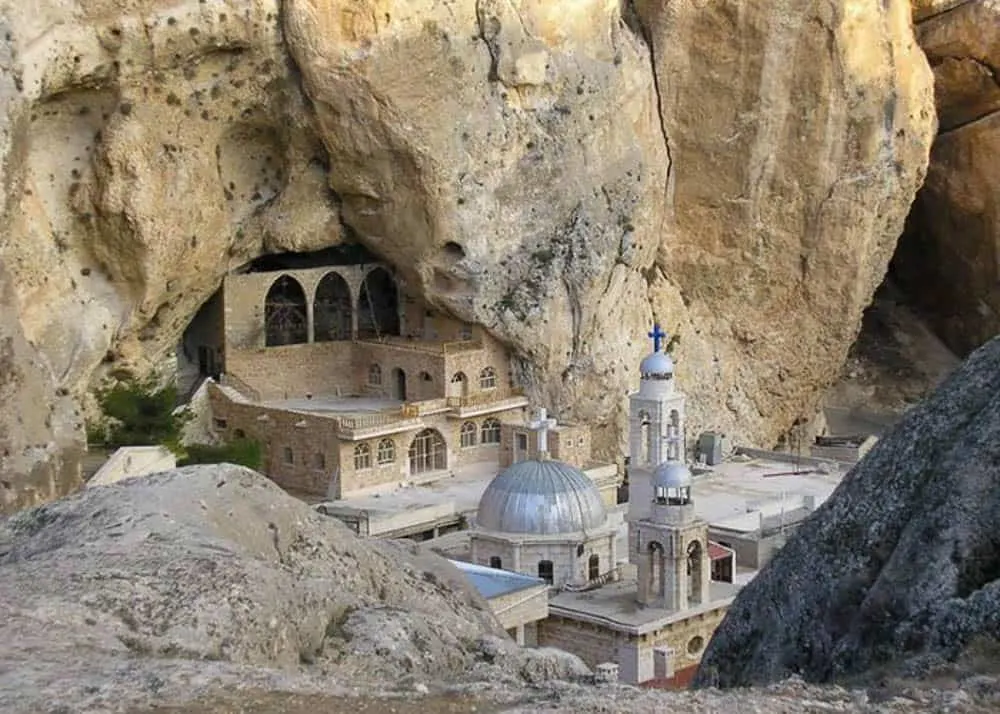
Maaloula is a famous town located in Syria, situated around 56 km towards the northeast of the country’s capital. It was constructed into the rugged mountainside at an altitude of more than 1500 meters.
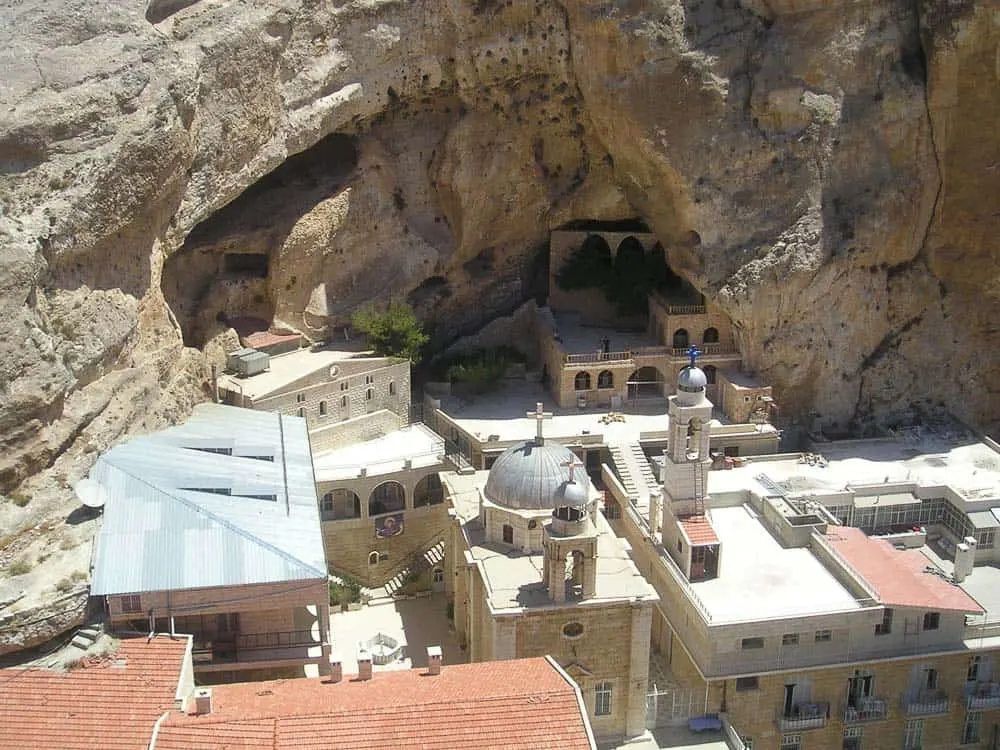
For the Muslim inhabitants, the legacy is all the more remarkable given that they were not Arabized, unlike most other Syrians who, like them, were Islamized over the centuries but also adopted Arabic and shifted to an “Arab” ethnic identity.
Tartous: The Safest City During The War
SeaSide Tartous
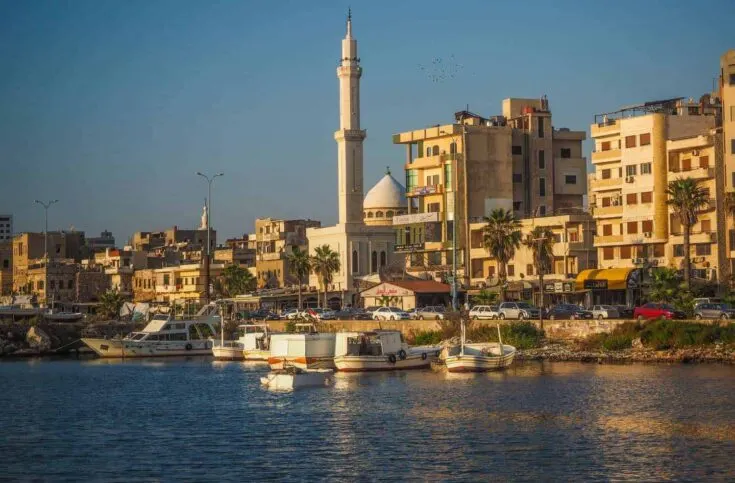
The city of Tartus (Tartous, is also correct) was the safest city during the Syrian War.
This Mediterranean coastal city is your base for visiting Amrit, the best-preserved temple in the world of the Phoenicians dating back more than 4,000 years ago.
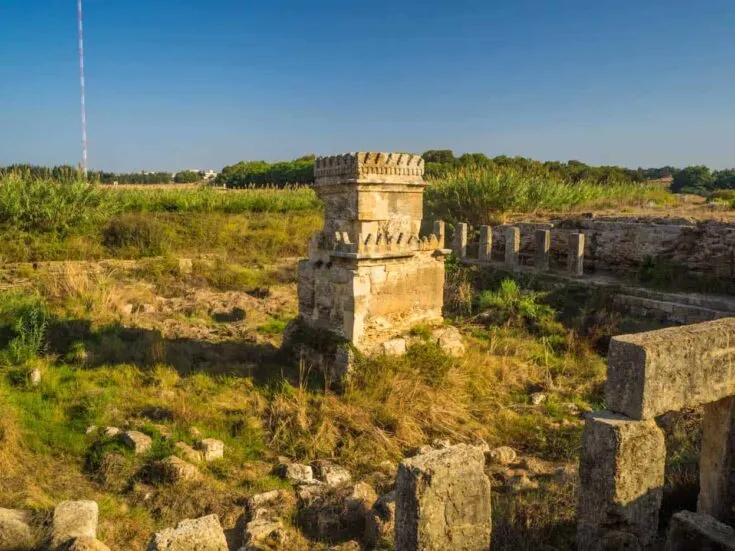
You can also find several tombs here in the countryside close to Tartus, as well as well-preserved landmarks in Syria.
Click here to read more about visiting Tartous.
Syria is full of history as this area is where they found some of the oldest settlements on earth.
What about a stadium that was built long before the Greek Olympic stadiums? This is where the Greeks got their inspiration from. 230 meters long and 35 meters wide. It was used for horse races, etc.
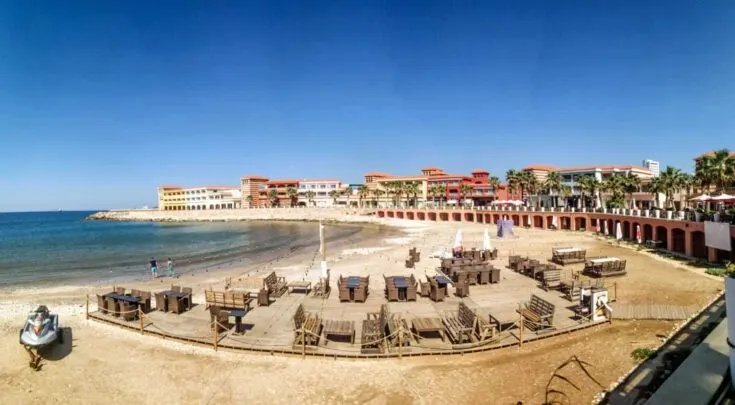
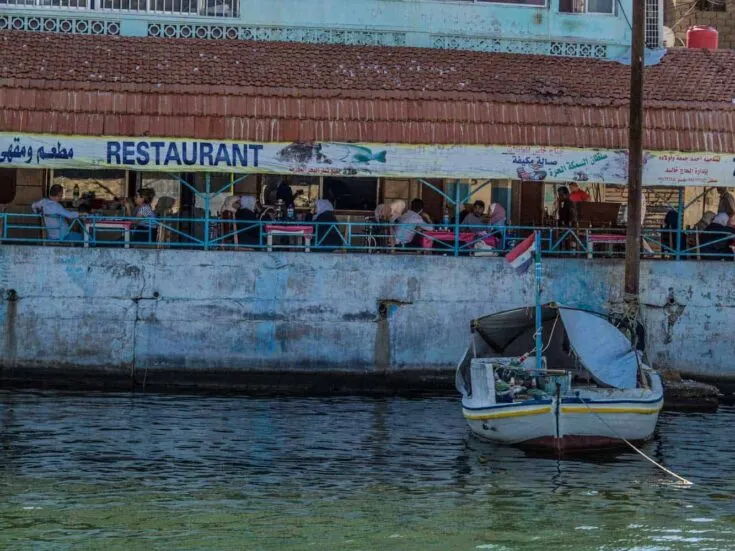
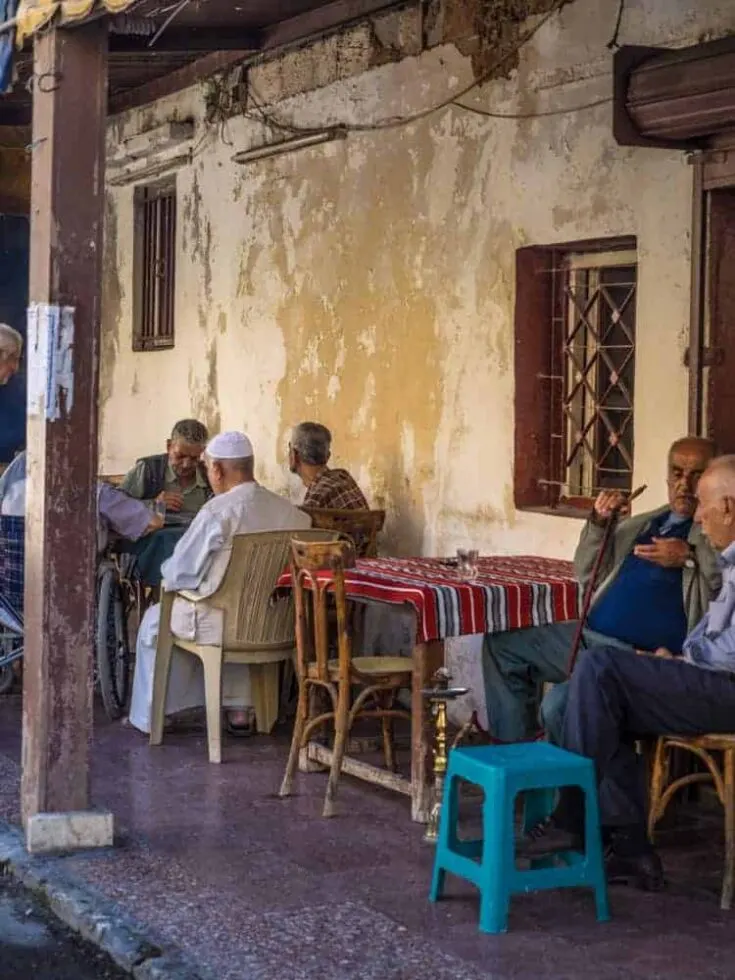
Sednaya: A Fascinating Mountain Village
Sednaya was a great place to visit in Syria. This mountain village, located 1,500 meters above sea level, is most famous for its Greek Orthodox Monastery on top of a hill.
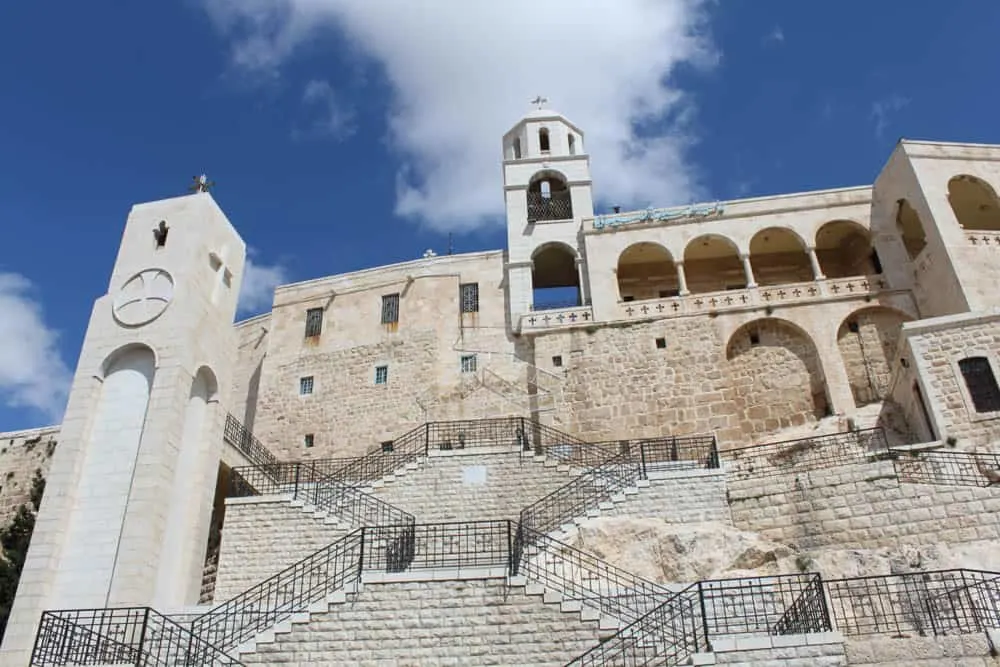
According to the legends of the Christians AND the Muslims, the Holy Virgin Mary appeared here at the Our Lady of Saidnaya Monastery.
Climb up to the top of the monastery for amazing views over this mountain village.
Sednaya is located only 30 kilometers north of the capital city of Damascus and is easy to visit on a day trip from Damascus.
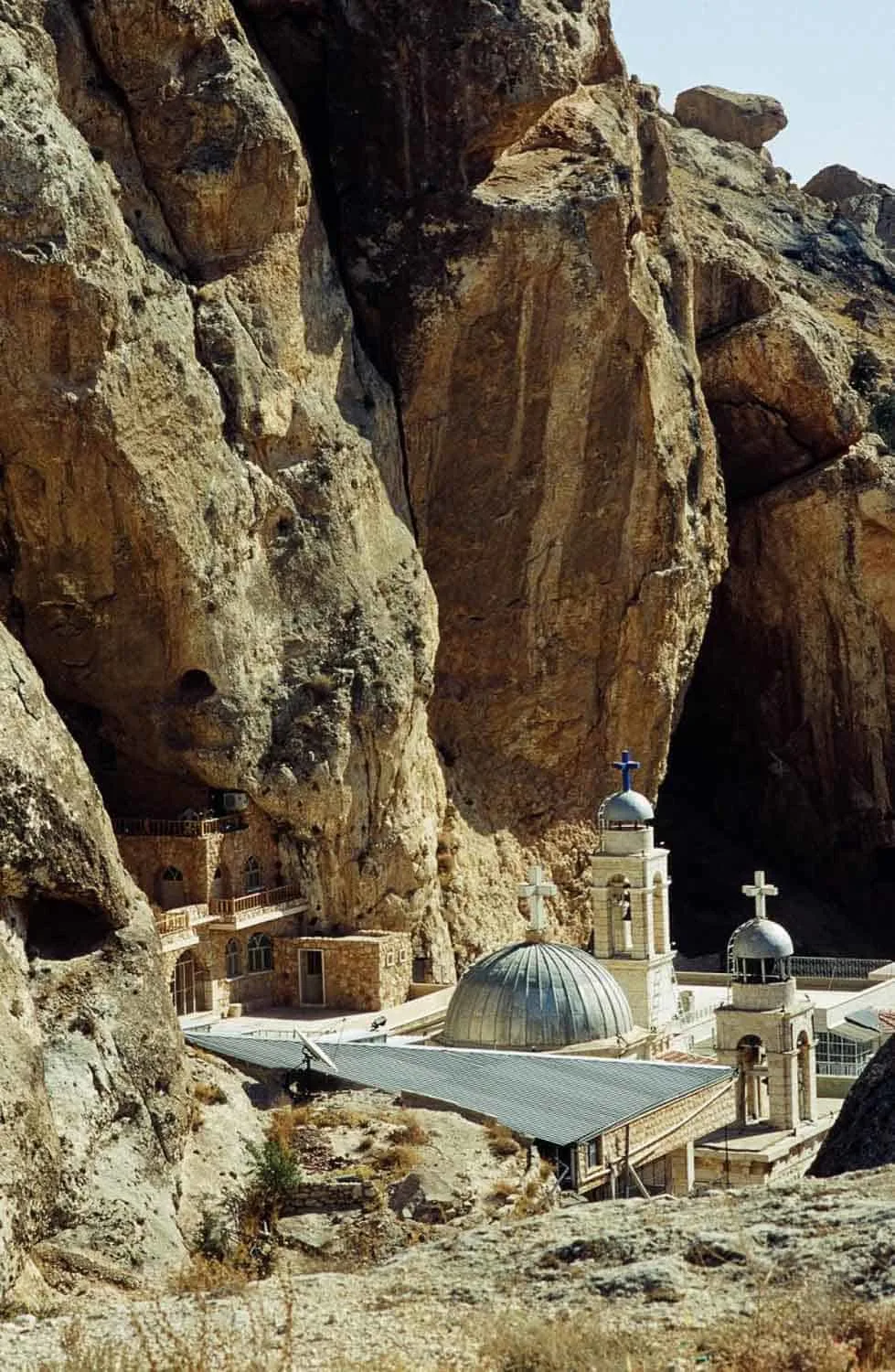
Other Syrian Historical Sites
The Roman Ruins of Apamea, which was retaken by the Syrian Government in 2019, is now open for tourists again, but the place was looted, and thousands of holes were all over the area looking for historical treasures.
Ebla also recently opened for tourists again.
Syria Famous Places That You Can Not Visit Anymore
While most of the historical places survived, so are there also, unfortunately, places that you can not visit anymore.
The Dead Cities and the famous Church of Saint Simeon Stylites, which are both in Idlib, are completely off-limits these days due to the fact they are located in terrorist-held areas.
The Ain Dara Temple is also off-limits in Turkish-controlled areas.
Qasr al-Hayr al-Sharqi fort in the Syrian desert is currently not safe to visit; the same is Mari and Dura-Europos; all 3 are located in government-controlled areas but are not safe.
The famous Mar Elian Monastery was completely destroyed by ISIS in 2015.
Raqqa and Resafa/Sergiopolis are also not possible to visit yet.
Visit Famous Places In Syria
Traveling to Syria these days is not straightforward.
But once you’ve made your way to the country, you’ll be rewarded with the most incredible experience.
While you won’t have the classic experience of tourism, you’ll be in a world of wonder that’s riddled with history and culture.
You can contact Ayoub from Marrota Travel; [email protected] +963954840021, which I highly recommend.
He’ll show you the best attractions in Syria, and he’s reliable.
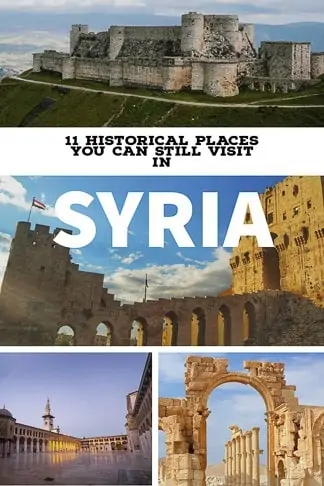

MB
Thursday 24th of December 2020
Thank you for the update. I traveled all over Syria in 2010 just 6 months before the conflict began. It was an amazing trip of a lifetime and I have been hoping to return ever since. When I visited al-Sharqi there were only a handful of visitors! My favorite was Bosra where I took a local bus from Damascus and met a college student on the bus who played tour guide and took me all over including a wedding reception and prayers at his local mosque. Such memories!
Dana ALDAOUD
Saturday 22nd of January 2022
@Christian L., Hello dear you can visit Syria now .Syria is welcoming you again for any information you can contact me Dana
Christian L.
Thursday 24th of December 2020
I'm sure that was an amazing trip. Luckily so will it be possible to visit Syria once the covid situation is over. I Always wanted to visit al-Sharqi, and from what I've heard so is it still standing and undamaged so I will be visiting when the situation allows it.